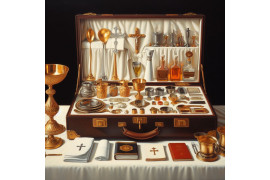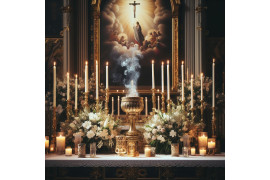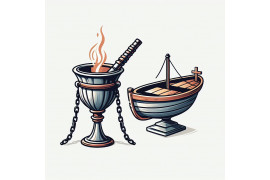The single golden candlestick in the Tabernacle of Moses held significant symbolism. It represented divine light and served as a powerful visual reminder of God's presence among His people. This intricate piece of furniture, made entirely of gold, was not merely a decorative item but carried deep spiritual meaning.
The candlestick symbolized spiritual enlightenment and guidance, illuminating the way for those seeking to follow God's path. Its seven branches were adorned with almond-shaped cups that held pure olive oil, which fueled the flames and emitted a warm glow throughout the sacred space.
Understanding the significance of the candlestick helps us grasp its role in worship and its connection to God's divine presence.
Design and Dimensions of the Candlestick (Exodus 25:31-40)
The design and dimensions of the candlestick in the Tabernacle of Moses were truly remarkable. Made of pure gold, it showcased intricate craftsmanship that reflected the importance and significance of this piece in the sacred space.
Made of Pure Gold with Intricate Craftsmanship
The candlestick was crafted from pure gold, symbolizing its purity and value within the Tabernacle. Skilled artisans meticulously shaped and formed this piece, ensuring every detail was carefully executed. The use of gold added to its aesthetic appeal and highlighted its sacred nature.
Consisted of a Central Stem with Six Branches
The candlestick featured a central stem with six branches extending from it. This unique design allowed for multiple sources of light to illuminate the Tabernacle, creating a warm and inviting atmosphere. Each branch was strategically positioned to provide an even distribution of light throughout the space.
Each Branch had Three Almond-Shaped Cups, a Knob, and a Flower
On each branch, there were three almond-shaped cups, resembling blossoms or buds. These cups held olive oil that fueled the flames, providing illumination within the Tabernacle. Each branch had a knob and a flower-like ornament at its tip, adding an exquisite touch to the overall design.
The almond-shaped cups symbolized life and fertility, while representing God's provision for His people. The knobs represented unity among believers as they gathered to worship in one accord. The flower ornaments added beauty and elegance to this sacred piece.
The Function of the Candlestick within the Tabernacle Structure
The candlestick in the Tabernacle of Moses served an important purpose within the holy place. It was placed opposite the Table of Showbread and provided light for the priests as they carried out their duties. This emphasis on illumination highlights its significance in worship.
Placed in the Holy Place opposite the Table of Showbread
The candlestick, also known as the menorah, was strategically positioned in the Tabernacle's Holy Place. It stood directly across from the Table of Showbread, which held twelve loaves representing each of the twelve tribes of Israel. This placement symbolized a connection between light and sustenance, underscoring their importance in spiritual life.
Provided light for priests during their duties
One primary function of the candlestick was to provide light within the Tabernacle. As there were no windows, this golden lamp stand illuminated the area where priests performed their sacred tasks. The seven branches adorned with lamps ensured that there was ample light to carry out various rituals and ceremonies.
Emphasized the importance of illumination in worship
The presence of light through the candlestick had a symbolic meaning within ancient Hebrew worship practices. Light represented God's guidance and revelation, leading His people on their spiritual journey. Just as physical darkness can hinder vision and clarity, spiritual darkness can obscure understanding and hinder one's relationship with God.
By providing continuous light, even amidst an otherwise dark environment, it conveyed an essential message: God is always present and provides illumination for those seeking Him. The candlestick reminded worshipers that they should strive to walk in His divine light and truth.
In addition to its symbolic significance, practical considerations were also at play. The priests needed sufficient lighting to perform their duties accurately and effectively. The intricate rituals involved precise movements and attention to detail; therefore, adequate lighting was crucial for them to carry out these tasks correctly.
The candlestick's presence within the Tabernacle served as a constant reminder of the importance of seeking God's illumination and guidance in one's spiritual journey. It encouraged worshipers to approach their relationship with Him with reverence, understanding that His light would lead them on the right path.
Role of the Candlestick in Providing Light and Illumination
The candlestick in the Tabernacle of Moses played a crucial role in providing light and illumination. It was not just an ordinary lamp stand; it had significant practical and symbolic significance.
Utilized olive oil to fuel its seven lamps
The candlestick, also known as the menorah, was fueled by olive oil. This oil was carefully prepared and used to keep the seven lamps burning continuously. Olive oil was chosen for its purity and quality, ensuring a steady source of light within the Tabernacle.
Ensured continuous light inside the Tabernacle
One of the primary functions of the candlestick was to ensure that there was always light inside the Tabernacle. The seven lamps were lit every evening and kept burning throughout the night until morning. This continuous source of light allowed priests to perform their duties and rituals even during nighttime hours.
Illuminated both practical tasks and symbolic significance
The candlestick served a dual purpose: it provided practical illumination for various tasks performed in the Tabernacle, while also carrying deep symbolic meaning. As a source of light, it enabled priests to carry out their responsibilities effectively, such as preparing sacrifices or tending to sacred objects.
Symbolically, the candlestick represented enlightenment, knowledge, and spiritual guidance. It symbolized God's presence among His people, illuminating their path through life's darkness. The true light that emanated from the candles reminded them of God's eternal wisdom and truth.
The seven lamps on the candlestick also held symbolic significance. They represented perfection or completeness, reflecting God's divine attributes. Each lamp stood for different qualities like love, joy, peace, patience, kindness, goodness, faithfulness - all essential aspects in leading a righteous life.
In addition to its symbolism within religious rituals and practices, the candlestick also had broader implications for leadership within ancient Israelite society. The leaders of the community were often referred to as "lights" or "lamps," signifying their role in guiding and illuminating the path for others.
The candlestick's presence in the Tabernacle served as a reminder to both leaders and individuals that they should strive to be sources of light and inspiration, leading by example and shedding light on truth and righteousness.
Connection between the Candlestick and Worship in the Tabernacle
The candlestick in the tabernacle of Moses held great significance in the worship practices of ancient Israel. It was not merely a source of light, but it represented their commitment to follow God's commandments and enhanced reverence and awe during worship ceremonies.
Associated with daily rituals performed by priests
The candlestick played a vital role in the daily rituals carried out by the priests within the tabernacle. Each day, a priest would enter the holy place and tend to the candlestick, ensuring that it was properly maintained. This included trimming the wicks and replenishing the oil so that it could continue to burn brightly throughout the night.
Represented Israel's commitment to follow God's commandments
The presence of the candlestick symbolized Israel's dedication to following God's commandments. Just as light illuminates darkness, their commitment to obedience illuminated their path towards righteousness. The flame burning on the candlestick served as a reminder for them to walk in God's ways and live according to His laws.
Enhanced reverence and awe during worship ceremonies
During worship ceremonies, especially those led by priests or even high priests, the candlestick added an element of reverence and awe. The flickering flames created a sacred ambiance, casting shadows against the walls of the tabernacle. This visual spectacle heightened their sense of spirituality and reminded them of God's presence among them.
The connection between worship and lighting can also be found in various psalms written by King David. In Psalm 119:105, he writes, "Your word is a lamp for my feet, a light on my path." Here, David acknowledges that God's Word serves as guidance in his life, just like how a lamp provides illumination along a dark path.
In addition to its symbolic significance within worship practices, there are deeper spiritual meanings associated with the candlestick. For example, the seven lamps on the candlestick represent the seven spirits of God mentioned in the book of Revelation. These spirits are believed to be manifestations of the Holy Spirit's fullness and power.
The candlestick also serves as a metaphor for believers in modern-day churches. Just as it provided light and guidance in the tabernacle, Christians are called to be a light in this world, spreading the gospel and reflecting God's love to others. The flame on the candlestick can be seen as a representation of the Holy Spirit working within believers, igniting their faith and empowering them to carry out acts of kindness and share the message of salvation.
Spiritual Interpretations and Lessons from the Golden Candlestick
The golden candlestick, also known as the golden lamp stand, holds significant spiritual interpretations and lessons for believers. It serves as a tangible representation of God's light and offers guidance on how individuals can live out their faith in practical ways.
Teaches believers about their role as bearers of God's light
The golden candlestick symbolizes the responsibility that believers have to carry and share God's light with others. Just as the candlestick was made of pure gold, which represents the divine nature, Christians are called to reflect the character of God in their lives. This means displaying love, kindness, forgiveness, and other virtues that illuminate a dark world.
Encourages spiritual growth through seeking divine illumination
The candlestick was fueled by pure olive oil, representing the Holy Spirit's presence and power in the life of a believer. It reminds individuals of the importance of seeking divine illumination through prayer, reading Scripture, and cultivating a personal relationship with God. By relying on the Holy Spirit's guidance, believers can grow spiritually and gain wisdom to navigate life's challenges.
Reminds individuals to shine brightly amidst darkness
In the Tabernacle, where darkness would have otherwise prevailed, the golden candlestick provided continuous light. This serves as a reminder for believers to shine brightly even when surrounded by darkness or facing difficult circumstances. The world needs people who are unafraid to stand up for what is right and bring hope into challenging situations.
The intricate design of the candlestick also holds spiritual significance:
-
The six branches extending from its central stem represent different aspects of a believer's life—such as family relationships, work responsibilities, friendships—and how each area should be illuminated by God's light.
-
The almond-shaped cups adorned with flowers symbolize fruitfulness and beauty that comes from living according to God's principles.
-
The use of bronze for its base signifies endurance and strength, reminding believers that their faith may be tested through sufferings and trials, but they can find resilience in God's presence.
By studying the golden candlestick, believers can gain insights into how to live a life that honors God and impacts those around them positively. It encourages them to let their light shine brightly and make a difference in the world.
Understanding the Profound Meaning of the Candlestick
We delved into its design and dimensions, its function within the tabernacle structure, and its role in providing light and illumination. We also examined the connection between the candlestick and worship in the tabernacle, as well as spiritual interpretations and lessons that can be derived from it.
By understanding the symbolism behind the candlestick, we gain a deeper appreciation for its purpose within the tabernacle. It served as a source of light in a sacred space, illuminating not only physically but also spiritually. The candlestick reminds us of our need for divine guidance and enlightenment in our lives.
To continue your exploration of biblical symbolism and gain further insights into ancient religious practices, we encourage you to browse through our other articles on related topics. Delve into the rich history and meaning behind various elements found within religious traditions to deepen your understanding of their significance.
FAQs
What materials were used to make the candlestick?
The candlestick in the tabernacle was made from pure gold. According to Exodus 25:31-40, it was crafted using a talent (approximately 34 kilograms) of pure gold.
How many branches did the candlestick have?
The golden candlestick had seven branches extending from a central stem. Each branch had decorative almond-shaped cups with oil lamps placed atop them.
What was the purpose of lighting candles on the golden candlestick?
The lighting of candles on the golden candlestick served both practical and symbolic purposes. Practically, it provided light inside the tabernacle, since there were no windows or natural sources of light. Symbolically, it represented God's presence as light illuminating His people's path.
Was there any specific way the candles were lit?
Yes, there was a specific procedure for lighting the candles on the golden candlestick. The priests had to use pure olive oil and ensure that the lamps burned continuously from evening until morning.
Is the golden candlestick still used in religious practices today?
The golden candlestick is not commonly used in modern religious practices. However, its symbolism and significance continue to be studied and appreciated as part of religious history and understanding ancient traditions.



